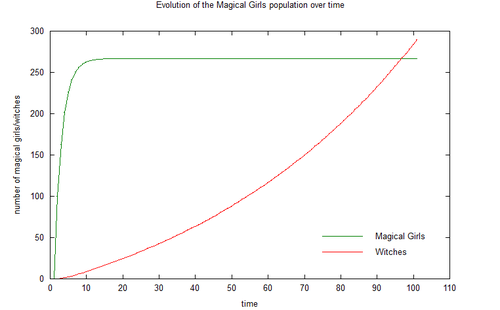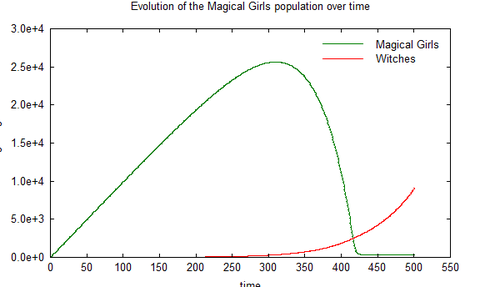Population dynamics
"You know about the food chain, right? I'm sure you learned about it in school. The witches eat the weak humans. And we eat those witches. That's the way stuff works, right?"
-Kyouko in Episode 5
As Kyouko alluded, the relationship between magical girls, witches, and the general population resembles a food chains in nature. However, magical girls and witches shares a unique relationship not typically represented in predator-prey equations: when a magical girl's soul gem darkens completely, she reborns as a witch (as revealed in Episode 8). This relationship leads to a more complicated interdependence between the two populations, one unaccounted for in standard population modeling. Due to this, a new population model needs to be developed specifically for these magical creatures to properly analyze their population dynamics.
Model assumptions
Both the magical girl and witch populations draw their numbers from the general human population. To simplify calculations, we assume that both populations are many magnitudes smaller in comparison to the overall human population, and human loses that result from magical activities contribute insignificant changes to it.
The magical girl population increases by the number of new girls Kyuubey contracted and decreases by the rate of them dying or becoming witches. The Witch population increase by the number of matured familiars per witch as well as the rate of magical girls that became witch, but decreases by the reate magical girls hunt and kill them. We can summarize these premises as the following variables:
- M(t): the number of magical girls at the time t (a natural number)
- W(t): the number of witches at the time t (a natural number)
- C: the number of girls Kyubey contracts at each iteration (a natural number)
- D: the proportion of magical girls dying at each iteration (a percentage)
- B: the proportion of magical girls becoming witches (a percentage)
- K: the proportion of witches killed at each iteration (a percentage)
- F: the number of familiars per witch that mature into witches (a percentage)
Simple model
A simple mathematical model was initially proposed but later refined (see below). In the simple model, the rate of magical girls dying, becoming witch, and witch-killing are assumed to be independent of the witch population. This have an effect of simplifying calculations and allows for a closed-form solution to the differential equations. Under this assumption, the populations can be defined as following:
Simulation
One 100-iterations execution of the simple model with Matlab, using a set of reasonable values for the variables:
For this simulation, we used the following values:
- C = 100;
- D = 0.25;
- B = 0.125;
- F = 0.015;
- K = 0.12;
- M(1) = 0;
- W(1) = 0;
- C/(D+B) = 267;
They might be inaccurate in terms of realism, but changing them shouldn't affect the general look of the graph (basically, the curves sharpness will vary, but not their general shape)
Population at Equilibrium
If both populations are in equilibrium, then there is no changes to both the witch and magical girl population [ΔM(t) = 0 & ΔW(t) = 0]. It follows that the number of magical girls contracted need to balance the number that died or become witch in the same period [C = (D + B) M(t)]; and the number of witches matured from minions balances out numbers contributed by magical girls [N * W(t) = (K - B) M(t)].
- At equilibrium, the magical girl population is equal to C / (D + B).
- At equilibrium, the witch population is (B - K) M(t). If the Magical Girl population is also in equilibrium, then the witch population is C*(B - K)/(D + B).
General Solution
The general solution for the witch and magical girl populations are:
for some constant α and β. If we assume witches and magical girls are introduced by QB's civilization, thus initial population of both at the system's introduction were zero [M(0)=0 W(0)=0]. W(t) and M(t) becomes:
Conclusions and observations
- Every dead magical girl is one that did not become a witch. For Kyuubey, whose goal is to harvest energy from the magical girl-to-witch transformation, every death meant wasted time contracting the girl. It makes sense for him to design a system where most Witches are weaker than Magical Girls in order to reduce magical girl casualty rate. [B > D]
- If magic girls are stronger than witches, it follows that the typical Magic Girl will kill multiple Witches before becoming one [K - B > 0]. Because of this, there's a need for an alternative source for creating witches. This explains why while Kyuubey cares only of the energy from Magic Girl-Witches transformation, the supplementary system of witch growth from familiars exist.
- The magical girl population will always reach equilibrium at C / (D + B), regardless of initial number of magical girls or actual values of C, D, or B. This restrain by Kyuubey's ability to contract new girls may explain why there seems to be so few magical girls around.
- Even when a significant number of magical girl is introduced initially, their numbers will eventually whithered down to sustainable population level of C/ (D + B). This is a natural consequence of limited linear growth rate and independent of environmental or crowding stresses.
- In contrast, the witch population never reach equilibrium. The number of witches will fluctuate minutely at the initial period, but inevitably the minion growth [e^Nt] will outpace all other variables, and the population will explode into exponential growth. The growth may be capped due to human depopulation from witch activities, but at this point the initial premises of the model breaks down.
- Due to the above, any planet with this magical girl and witch system in place is inevitably doomed to extinction. It is not possible to save the human population, with exception of exterminating all witches and magical girls. This may explain why Kyuubey simply abandoned Earth rather than attempt sustainable farming of the planet.
Refined model
The main flaw with the simple model is that the amount of magical girls getting killed doesn't vary with the amount of witches, which leads to an inconsistent behavior. We can change this model as follows:
- We assume in this model that magical girls fight witches one-on-one.
- When magical girls are outnumbered by witches, we assume a certain proportion of said magical girls goes to fight the witches at each iteration, the others are supposed to rest, heal from previous fights, or just live a normal life.
- When the amount of magical girls is superior of the amount of witches, only a certain amount of magical girls fight witches. Hence, both B (the proportion of girls becoming witches) and D (the proportion of magical girls dying) are variable with the amount of witches.
- We assume one can turn into a witch only by using magical powers (the soul gem doesn't dim over time), and that magical girls only use magical powers against witches (they don't fight each other)
- We assume there was at least one witch when t=0. If not, then no magical girl would turn into a witch; W(t) would always equal zero, and M(t) would be linear (or rather, logistic if we want to be realistic).
The Model
All that's left is to put that into a mathematical formalism. Here goes:
- The constants defined above are kept as-is
- Let P be the proportion of Magical Girls that fight witches (so, if P=0.8, 20% of the magical girls will rest at each iteration)
- The system becomes
Simulation
When executing this code in Matlab, we get the following result:
For this simulation, we used the following values:
- C = 100
- D = 0.25
- B = 0.125
- F = 0.015
- K = 0.12
- p = 0.8
Like for the case above, these values may be unrealistic, but they shouldn't affect the general shape of the curves, as long as the constraints are followed.
Comparisons between the two models
The populations undergo two distinct period of development:
- Initially, the number of magical girls grows in a quasi-linear trend. Since there is almost no witch, so there are few magical girl casualties. Kyubey still contracts them on a regular basis, so naturally the number grows at a near constant rate. Since less battling occur, soul gem darken slowly, and the number of magical girls that become witches are comparably smaller. Due to this, the witch population grown at a slower rate than the simple model.
- At a critical time (t=350 in this simulation), the witch population becomes significant. Increased opportunity of witch hunt start having an effect on magical girls: magical girl population growth slows then begin to fall, while the witches population increase at an accelerated rate. Eventually the number of magical girls reach equilibrium at C/(D+B), and the witch population achieves exponential growth.
The simple model fails to account for this initial period of population development and reach equilibrium at a much faster time. However, the secondary period corresponds to a time-delayed version of the simple model's general solution. Therefore, conclusions reached by the simple model hold true, although at a later time period than predicted.
Matlab Scripts
You can find the Matlab scripts for the two models presented above here:



